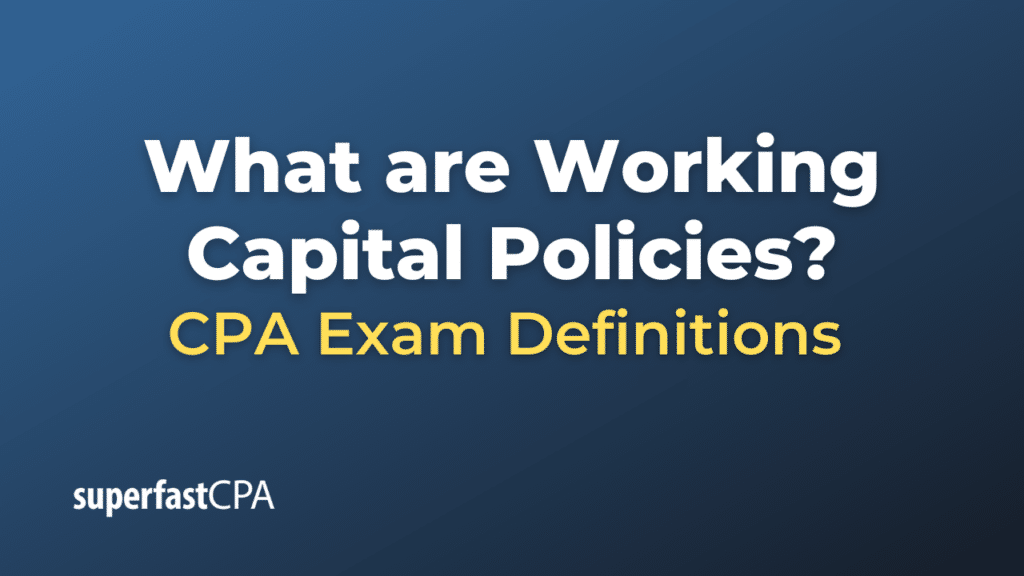Working Capital Policies
Working capital policies refer to the guidelines and rules set by a company to manage its working capital effectively. These policies usually focus on maintaining a balance between the company’s short-term assets and liabilities to ensure operational efficiency and financial stability. The goal is to make sure the company has enough liquidity to meet its day-to-day operating expenses while minimizing the cost of holding too much cash or other short-term assets.
Types of Working Capital Policies
- Conservative Policy: Under this approach, a company maintains a high level of working capital to ensure that it can meet its short-term obligations with ease. This usually means higher levels of cash, inventory, and accounts receivable. While this policy minimizes the risk of a liquidity crisis, it can result in lower returns on assets as more funds are tied up in non-productive assets.
- Aggressive Policy: This policy aims for minimum levels of working capital, tying up less money in short-term assets and depending more on short-term financing. While it maximizes profitability by increasing the turnover of assets, it can also lead to higher risk levels because of lower liquidity buffers.
- Moderate Policy: This is a balanced approach that falls between the conservative and aggressive policies. It aims to maintain working capital at an optimal level that is neither too high nor too low, balancing both profitability and risk.
Components of Working Capital Policies
- Inventory Policy: Guidelines for the minimum and maximum levels of inventory to be maintained, order sizes, and reordering procedures.
- Accounts Receivable Policy: This includes credit policies, such as how much credit to extend to customers, the length of the credit period, early payment incentives, and collections procedures.
- Accounts Payable Policy: Rules for the timing of payments to suppliers, including negotiation of terms for maximizing payment periods without incurring penalties.
- Cash Management Policy: Instructions for maintaining specific cash balances, including investment policies for any excess cash and guidelines for obtaining any required short-term financing.
- Short-Term Financing Policy: Guidelines for utilizing different sources of short-term finance, such as bank loans, trade credit, and commercial paper.
Advantages of Having a Defined Working Capital Policy
- Strategic Alignment: Helps in aligning the working capital management strategies with the company’s overall financial and operational objectives.
- Operational Efficiency: Provides a framework for managing the company’s short-term assets and liabilities efficiently.
- Risk Management: Helps in understanding and managing the trade-offs between liquidity and profitability.
- Accountability and Control: With a defined policy, it’s easier to hold different departments accountable for their roles in managing components of working capital.
- Investor and Stakeholder Confidence: A well-defined and well-executed policy can improve stakeholder confidence by demonstrating a commitment to financial stability and operational efficiency.
Companies often revisit and revise their working capital policies to adapt to changing business environments, regulatory changes, and financial conditions. Effective working capital policies are tailored to a company’s specific industry, business model, and financial situation.
Example of Working Capital Policies
Let’s consider a fictional example of a small e-commerce company, “GizmoHub,” specializing in selling electronic gadgets. We’ll see how the company devises its working capital policies to address its unique business needs.
GizmoHub’s Financial Situation:
- Current Assets: Cash ($10,000), Accounts Receivable ($30,000), Inventory ($25,000)
- Current Liabilities: Accounts Payable ($20,000), Short-term loans ($5,000)
Working Capital Policies:
Inventory Policy:
- Maximum Level: Inventory worth $30,000
- Reorder Level: When inventory value drops to $15,000, a reorder is triggered.
- Minimum Level: Inventory worth $10,000 to account for unexpected demand surges.
Accounts Receivable Policy:
- Credit Period: 30-day credit term for customers.
- Early Payment Incentive: 2% discount for payments made within 10 days.
- Collection Effort: Automated reminders sent at 25, 35, and 45 days.
Accounts Payable Policy:
- Payment Terms: Aim for a 45-day payment window with suppliers.
- Discounts: Utilize early payment discounts when cash flow is robust.
Cash Management Policy:
- Minimum Cash Balance: Maintain a minimum of $5,000 for operational expenses.
- Excess Cash: Any cash above $15,000 will be invested in low-risk, short-term marketable securities.
Short-Term Financing Policy:
- Line of Credit: Maintain a line of credit worth $10,000 for emergency needs.
- Use of Short-Term Loans: Only to be considered when the line of credit is exhausted.
Implementing the Policies:
- Inventory: GizmoHub utilizes an automated inventory management system that triggers reorder points based on their policy.
- Accounts Receivable: A CRM system is set up to manage customer invoices, automatically send reminders, and apply early payment discounts.
- Accounts Payable: GizmoHub uses accounting software to schedule supplier payments according to negotiated terms and to take advantage of early payment discounts when appropriate.
- Cash Management: The company reviews its cash position weekly. If cash exceeds $15,000, short-term investments are made.
- Short-Term Financing: GizmoHub maintains a line of credit with a local bank and reviews the terms annually.
Benefits:
- Liquidity: The policies help maintain adequate liquidity to meet operational needs.
- Efficiency: Automation based on the policies ensures efficient operations.
- Profitability: By optimizing the use of resources, the company aims for higher profitability.
- Risk Management: The balanced approach between aggressive and conservative policies minimizes financial risks.
By setting and adhering to these working capital policies, GizmoHub is able to manage its short-term assets and liabilities effectively, ensuring that it can meet its financial obligations while also pursuing growth opportunities.













